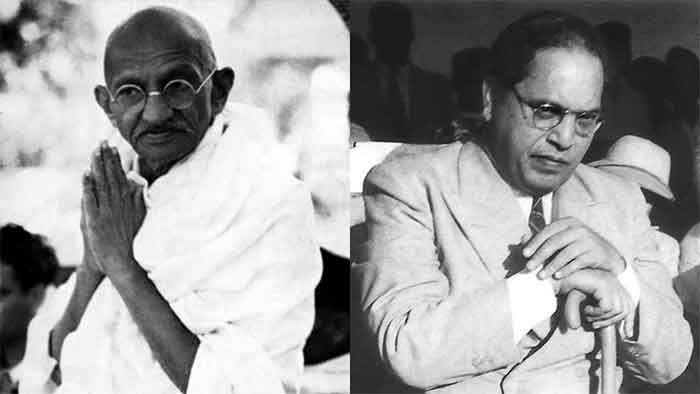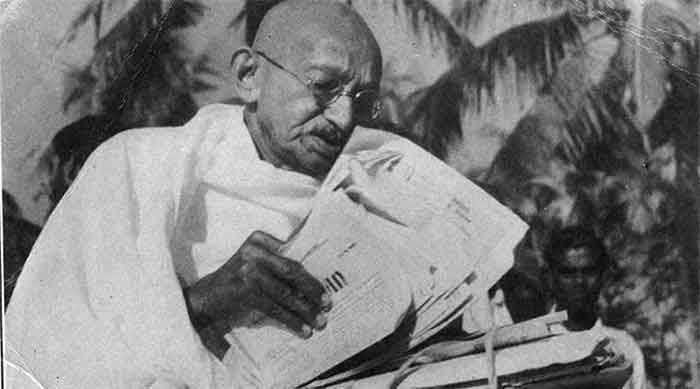
The fight between Bharat Ratna Baba Saheb Dr. Bhim Rao Ambedkar (1891-1956) and M.K. Gandhi (1869-1948) is well documented in the chronicles of Indian history. Dr. Ambedkar was a champion of the downtrodden whereas Gandhi was an ardent supporter of Hinduism and promoted all rubbish traditions, rituals of Brahminism.
Gandhi believed in the sanctity of Manusmritithat ordains & sanctifies the age-long oppression & exploitation of the Untouchables by Hindus. Gandhi was a hard-core promoter of Manusmriti, Gita, Shankaracharya`s Vedant, Mahabharat, Ramayana and the Puranas. The Ramayana used to be regularly read in Gandhi`s family. A Brahmin called Ladha Maharaj used to read it.[1] According to Dr. Ambedkar, the three authors of the Vedas were buffoons, knaves & demons.[2]
Gandhi said that it is foolish to condemn Vyasa for his defense of the caste system.[3] On 25th Dec, 1927, Dr. Ambedkar burnt the ‘Manusmriti’. In an interview with T.V. Parvate in 1938 Dr. Ambedkar said, “The bonefire of Manusmriti was quite intentional, we made a bonefire of it because we view it as a symbol of injustice under which we have been crushed across centuries.”[4] Dr. Ambedkar was an atheist. On 29 Aug,1931 when Gandhi travelled to London, he said to the media, ‘my faith in God, my advisor is God’.[5]
Dr. Ambedkar urges on the Mahar community, as a preliminary step towards the change of religion to refrain henceforth from worshiping Hindu deities to put a stop to the observance of Hindu festivals & to put a stop to visiting Hindu holy places.[6] Inter-dining or inter-marriage solution for getting rid of Untouchability was suggested by Dr. Ambedkar. Gandhi has most categorically stated that removal of Untouchability does not mean inter-dinning or inter-marriage between the Hindus and the Untouchables.[7]
Gandhi was an ordinary lawyer who never won any legal case for his client whereas Dr. Ambedkar was a Barrister -at -law and won several legal cases for his clients. Dr. Ambedkar fought for social, political and economic rights of the Scheduled Castes (SCs) and Scheduled Tribes (STs) and saw to it that ‘Reservation’ for the socially and economically backward Scheduled Castes (SCs) and Scheduled Tribes (STs) implemented and safeguarded in the constitution of India. Alone, Dr. Ambedkar won Reservation for the SCs and STs. The fruits of which now the SCs and STs are enjoying. Gandhi opposed separate electorate for the Depressed classes at the Round Table Conference in London. Not only opposed but also declared fast unto death against the Communal Award of his Majesty`s government. Dr. Ambedkar, on humanitarian ground saved Gandhi`s life while agreeing to the ‘Poona Pact’.
Gandhi took no interest in Bardoli programme which related to the Untouchables. The Satyagraha at the Kala ram Temple situated in Nasik, a town in the Nasik District of the Bombay Presidency, was organized to establish the rights of the Untouchables to enter Hindu temples. The Satyagraha movement was no doubt independent of the Congress . it was organized by the Untouchables, led by the Untouchables and Financed by the Untouchables. Dr. Ambedkar commented that Gandhi however did not give support to the Satyagraha. Not only did he not give his support, he condemned it in strong terms.[8] To throw open temple to the Untouchables, Gandhi said: “ How is it possible that the Antyajas( untouchables) should have the right to enter all the existing temples? As long as the las of caste and ashram has the chief place in Hindu religion, to say that every Hindu can enter every temple is a thing that is not possible today[9]”.
Dr. Ambedkar commented that ‘Gandhi’s anti-untouchability campaign is marked by so many twists and turns, inconsistencies and contradictions, attacks and surrenders, advances and retreats’ Gandhi collected 1 crore and 25 lakhs of Swaraj Fund, found that only 48 thousand rupees were allotted to the cause of the untouchables’.[10] Gandhi in his whole life undertook 21 fasts. In these 21 fasts there is not one undertaken for the removal of Untouchability.[11] On Gandhi `s half-hearted campaign on Untouchability, Dr. Ambedkar commented sarcastically, “there have been many Mahatmas in India whose sole object was to remove Untouchability to elevate & absorb the Depressed Classes , but every one of them has failed in his mission. Mahatmas have come & Mahatmas have gone. But the Untouchables have remained as Untouchables[12]”.
Gandhi began assaulting Dr. Ambedkar not alone but also with powerful, moneyed Birla family. At that period of time, Birla family was very close to Gandhi. The popular rather one can say securely that all social, economic and political agendas of Gandhi were organized by Birla family. Gandhi was against industrialization and thought machine as an evil thing whereas Dr. Ambedkar was progressive and thought that India can prosper only through industrialization. In Gandhi’s view, “western civilization is the creation of satan”[13].
On one occasion when British came to arrest him at night, they found Gandhi in bed with a girl of eighteen.[14] Girja Kumar commented in his book, “Gandhi had his massage practically naked with young girls as his masseurs”.[15] Sir C.P. Ramaswami Iyer,PM, of Travancore, told Mountabatton that , “Gandhi was a most dangerous , semi-repressed sex maniac”.[16].
According to Dr. Ambedkar, of all religions in the world it was Hinduism that recognized caste distinctions and Untouchability. Dr. Ambedkar embraced Buddhism on 14th October, 1956 a Nasik, Maharastra, along with million Dalit followers since he strongly believed that the Dalits if remains in the fold of Hinduism, would be persecuted forever. While announcing at Nachidatsu Fuji`s Japanese ( Nipponzon Myohoji) temple in Bombay that , “ he will dedicate the rest of life to the revival and spread of Buddhism( TOI 1Oct,1950; HT , 4May1950).
In responding to it Gandhi retorted: “ religion is not like a house or a cloak, which can be changed at will ( the Htavada, 16 October ,1935, in CWMG Vol.68:65).[17] While speaking at the Vesak celebrations in the Maha Bodi Society `s Dharmarajika vihara in Calcuatta , he ridiculed the Buddhist effort to take control of the Maha Bodi temple : “ what does it matter whether we go to a little temple and worship his [the Buddha`s] image or whether we even take his name… it is not necessary for millions to associate themselves with one man who seeks for truth(MBJ Vol.33/6,1925:312).[18]
Dr. Ambedkar was an earnest in his efforts to annihilate the caste system whereas Gandhi did not. Gandhi`s actions and thoughts suggest that he wanted the Dalits under the domination of Hindus. Dr. Ambedkar always wanted self-respect for the Dalits. In his book Dr. Ambedkar warned the Dalits by writing: “Beware of Gandhi”. Baba Saheb Dr. B. R. Ambedkar was not only critical of Gandhi but other world leaders also made stinging comments on Gandhi`s character and actions in respect of the Untouchables.
On 14th October, 1956, Baba Saheb Dr. Ambedkar embraced Buddhism in Nagpur with thousands of followers and wrote “The Buddha and His Dhamma” and gave new religion of Buddha to the Untouchables and urged them to become Buddhists and make sincere efforts to revive Buddhism in India.
Dr. Rahul Kumar Balley is a PhD in sociology from Jawaharlal Nehru University, New Delhi (India). He is an independent researcher. His area of interest encompasses social, political issues, diplomacy, foreign policy and international relations. The views expressed in this article are personal.
Note: In this article, Untouchables, Depressed Classes, Dalits are interchangeably used.
[1] Dr. Ambedkar (1978), Writings and Speeches, Government of Maharashtra, vol..9,p.241.
[2] Ibid, Vol.4, p.156.
[3] Ibid, Vol.I, p, 292.
[4] Ibid.Vol.17, part I, p.25.
[5] Ibid, Vol.17, part I, p.384.
[6] Ibid.Vol.17, part I, p.245.
[7] Ibid.Vol.9, p.294.
[8] Dr. Ambedkar Writings and Speeches, vol.9, p.247.
[9] Ibid. Vol.9,p.107.
[10] Ibid.Vol.9, p.254.
[11] Ibid.Vol.9, p.254.
[12] Ibid.Vol.9,p.315.
[13] Ibid.Vol.9, p.279.
[15] Girja Kumar (2006), Brahmacharya Gandhi & His Women Associates, New Delhi, Vitasta Publishing Pvt. Ltd, p.13.
[16] Dr. Ambedkar Writings & Speeches, Government of Maharashtra, Vol.17, part I, p.281.
[17] Ober Douglas (2023), Dust on the throne: The search for Buddhism in modern India, California, Stanford University, p.205.
[18] Ober Douglas (2023), Dust on the throne: The search for Buddhism in modern India, California, Stanford University, p.156.
















































